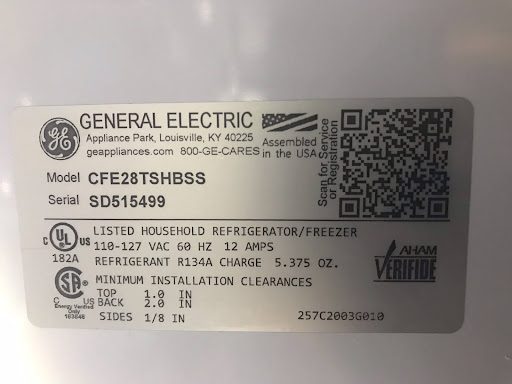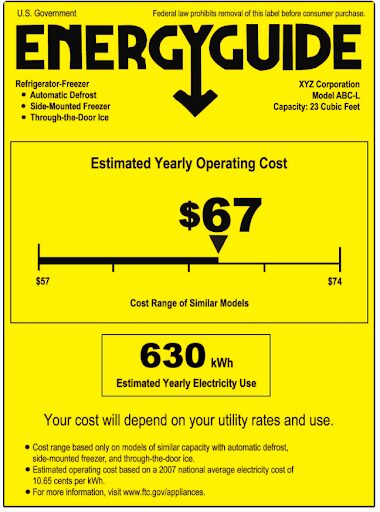How Many Watts Does a Fridge Use? Mini Fridge, Cost & More
by Tyler Castle
13.8 min read

Looking for ways to lower your electricity bill? Finding ways to save on electricity is a great way to keep money in your pocket. That’s why it’s important to understand how much power your appliances use. Outdated or inefficient appliances could be costing you money, even when they’re not in use!
This post takes a look at one of the larger appliances in your house that’s always on — your refrigerator.
How many watts does a fridge use?
For most full-sized residential refrigerators, the average wattage typically ranges between 300 to 800 watts when running.
Energy-efficient models may use less, sometimes as low as 150 to 400 watts, while older or larger units might consume more, potentially reaching up to 1,200 watts or more during operation.
The simplest way to determine how many watts your refrigerator uses will be to look at the rating plate (also called a nameplate) inside your fridge and search for the listed wattage or the number of volts and amps.

This nameplate shows that the refrigerator operates at a range of 110-127 volts and 12 amps.
Most nameplates will have the wattage listed, though if it isn’t then you can still calculate your wattage though its volts and amps.
- Volts (V): Short for voltage, volts measure the difference in electric potential between two points in an electrical circuit. This difference is what causes electric charges to flow from an outlet to your appliance. Electrical outlets in North America supply 120 volts, which is sufficient for most appliances.
- Amps (A): Short for amperes, amps measure electrical current. The amperage rating tells you the number of electrons flowing through a circuit, which is how much electrical current an appliance draws. Older, less efficient appliances will have higher amperage ratings.
How many amps does a refrigerator use?
The number of amps a refrigerator uses depends on its size, age, and efficiency.
On average, most standard residential refrigerators draw between 3 to 5 amps.
Larger models or those with additional features like ice makers and water dispensers may draw more current, while energy-efficient models may use less.
How many volts does a refrigerator use?
Most residential refrigerators in the United States operate on standard household voltage, which is 120 volts.
This is the standard voltage for most home appliances, including refrigerators. However, in some regions or for certain commercial or industrial refrigerators, the voltage may differ.
Calculating the wattage of your fridge
To find out how many watts a fridge uses per day, multiply the voltage by the amperage to determine how many watts your fridge uses, which will also tell you the rate of energy consumption. On average, most full-sized home refrigerators use between 300 to 800 watts of electricity.
Using the volts and amps from the nameplate above of 110 volts x 12 amps results in 1,320 watts.
However, it does get a little more complicated because your refrigerator is not actually running all the time (or if it is, then you have a problem with the refrigerator’s functionality). The compressor should be running only when needed to cool down the inside. The U.S. Department of Energy (DOE) recommends that you divide the total time the refrigerator is plugged in by three to account for the number of hours that your refrigerator is actually running — assuming a 24-hour day gives us eight hours of operation.
So, to find the annual kWh energy consumption of your refrigerator:
- Start by dividing the wattage by 1,000, which for our example is 1,320 / 1,000 = 1.32 kWh.
- Multiply that number by 8 to find the daily usage, 1.32 x 8 = 10.56 kWh.
- Multiply again by an average of 30 days for each month, 10.56 x 30 = 316.8 kWh/month.
- Then multiply by 12 to find the refrigerator’s annual energy usage, 316.8 x 12 = 3,801.6 kWh per year.
How many watts does a fridge use per day, month, and year
Energy Consumption of a Fridge by Wattage
| Wattage | Daily Usage (kWh) | Monthly Usage (kWh) | Yearly Usage (kWh) | |
| 350 watt fridge |
7.2 | 216 | 2,628 | |
| 500 watt fridge |
12.0 | 360 | 4,380 | |
| 800 watt fridge |
19.2 | 576 | 7,008 |
These values assume the fridge runs for approximately 24 hours per day.
How much electricity does a fridge use?
You can get an estimate of the energy cost of your refrigerator by calculating its monthly or annual kWH usage. The simplest way to determine a refrigerator’s kWH usage will be to look at its EnergyGuide label. Most appliances are required to have an EnergyGuide label that shows its estimated annual energy consumption and operating cost.
However, not all refrigerators will have an EnergyGuide sticker. If you need to estimate the kWh usage of your refrigerator, then you’ll have to determine how many watts of electricity your refrigerator uses.
Cost to Run a Full-sized Refrigerator (at U.S. Average of 17.11 cents per kWh as of March 2025)
| For 1 day (8 hours) |
For 1 week (7 days) |
For 1 month (30 days) |
For 1 year (365 days) |
|
| 350 watt fridge |
$0.48 | $3.34 | $14.29 | $173.80 |
| 500 watt fridge |
$0.68 | $4.76 | $20.42 | $248.29 |
| 800 watt fridge |
$1.10 | $7.61 | $32.67 | $397.26 |
Cost to Run a Full-Sized Refrigerator for 1 Year in Different U.S. States*
| Michigan 19.37 cents per kWh |
Pennsylvania 18.43 cents per kWh |
Ohio 16.12 cents per kWh |
Illinois 17.59 cents per kWh |
Indiana 16.52 cents per kWh |
|
| 350 watt fridge 1,022 kWh |
$197.98 | $188.36 | $164.86 | $179.78 | $168.87 |
| 500 watt fridge 1,460 kWh |
$282.80 | $269.08 | $235.35 | $256.81 | $241.99 |
| 800 watt fridge 2,336 kWh |
$452.36 | $430.69 | $376.55 | $410.91 | $385.77 |
*costs are based on EIA estimation of average kWH as of March 2025.
How many watts does a mini fridge use?
The wattage of a mini fridge generally ranges between 100 to 400 watts. Here’s a more detailed breakdown:
- Small Mini Fridges: Around 100 to 200 watts
- Medium Mini Fridges: Around 200 to 300 watts
- Larger Mini Fridges: Up to 400 watts
The actual wattage can vary depending on the model, size, and features of the mini fridge. For the most accurate information, you can check the specifications label on the appliance or consult the manufacturer’s manual.
Calculating the wattage of your mini fridge
Calculating how many watts your mini fridge uses is simple. To determine the wattage, let’s say that the nameplate on your mini fridge uses your unit uses 110 volts and 12 amps. Multiply the voltage by the amperage; in this case, we get 1,320 watts. That’s how you can determine the wattage of your mini fridge.
To calculate your daily energy consumption, first, determine how long your mini fridge runs on a daily basis. Let’s assume your mini fridge should run 8 hours a day. You’ll need to convert wattage to kilo-watt hours by dividing your wattage (for our example it’s 1,320 watts), by 1,000. This is the equal number of watts a kilowatt hour.
Here’s the calculation: 1,320 watts ÷ 1,000 = 1.32 kWh.
To find your daily use, take 1.32 kWh and multiply it by how many hours in a day your unit is running:
Daily Usage: 1.32 kWh × 8 hours = 10.56 kWh
To find the monthly energy consumption of a mini fridge, take your daily kWh (10.56 kWh), and multiply it by the average days per month:
Calculation: 10.56 kWh × 30 days = 316.8 kWh
To find out how much energy a mini fridge uses per year, take your monthly usage (316.8 kWh) and multiply it by 12:
Calculation: 316.8 kWh × 12 = 3,801.6 kWh per year
So, a mini fridge with these specifications would consume approximately 3,801.6 kWh per year.
If you have specific voltage and amperage values for your mini fridge, you can substitute those into the formula to get a more accurate estimate.
How much electricity does a mini fridge use?
On average, a mini fridge consumes around 1.6 kWh per day, which translates to approximately 48 kWh per month and 576 kWh per year.
This variation is influenced by factors such as ambient temperature and usage patterns. The exact amount of electricity it consumes depends on the size and efficiency of the unit, as well as how often the compressor runs.
How much electricity does a mini fridge use per month, day, week, and year?
Cost to Run a Mini Refrigerator (at U.S. Average of 17.11 cents per kWh)
| For 1 day (8 hours) |
For 1 week (7 days) |
For 1 month (30 days) |
For 1 year (365 days) |
|
| 50 watt fridge |
$0.07 | $0.48 | $2.05 | $25.02 |
| 100 watt fridge |
$0.14 | $0.96 | $4.11 | $50.04 |
And here’s a comparison of annual electricity costs for different states based on the average kWh charges for 8 hours a day.
Cost to Run a Mini Fridge for 1 Year in Different U.S. States*
| Michigan 19.37 cents per kWh |
Pennsylvania 18.43 cents per kWh |
Ohio 16.12 cents per kWh |
Illinois 17.59 cents per kWh |
Indiana 16.52 cents per kWh |
|
| 50 watt fridge146 kWh |
$28.27 | $26.91 | $23.54 | $25.69 | $24.12 |
| 100 watt fridge292 kWh |
$56.54 | $53.82 | $47.08 | $51.39 | $48.23 |
*costs are based on EIA estimation of average kWH as of March 2025.
Factors that influence your fridge’s energy consumption
The actual kWH usage of your refrigerator throughout any day will depend on a number of key factors:
- Type — Larger refrigerators will use more electricity, and certain designs are more or less energy efficient. For example, models with the freezer on top tend to use less energy than other designs, and those with a fewer number of doors will leak less air.
- Ambient temperature — If your refrigerator is in a warm area or is poorly ventilated, then it will have to use more power to stay cool. Also, your refrigerator will use more energy in summer if the ambient temperature in your house is high.
- Internal temperature — Your set internal temperature will also determine how much energy your fridge uses. Fresh food should be stored around 35°-38°F but the factory setting may be colder than needed.
- Usage — If your refrigerator is in constant use then it will need to work harder. The more frequently a fridge door is opened or held open, the harder the compressor will need to work.
- Storage — Storing warm food within a fridge will require more energy to cool down. An empty fridge will actually need to work harder than a stocked fridge because more of the cooler air escapes when a door is opened.
- Condition — Not only are older refrigerators less energy efficient than newer, EnergyStar-rated fridges, all refrigerators will wear down and lose efficiency over time. As your refrigerator’s door seals wear down, the more cool air will escape.
There are a lot of factors that can increase your refrigerator’s energy usage over the estimated average. If you definitely want to know how much energy your refrigerator uses, then you’ll have to use a wattmeter/power meter to accurately measure its power consumption. You can find and purchase an electricity usage monitor at most hardware stores for around $25-$50.
How long does a refrigerator last?
The average lifespan of a refrigerator typically ranges from 10 to 15 years. However, this can vary depending on the brand, model, and how well the appliance is maintained.
High-quality, well-maintained refrigerators may last up to 20 years, while older models or those with frequent issues might have a shorter lifespan.
Signs you need a new fridge
- Inconsistent Temperature: If your refrigerator is having trouble maintaining a consistent temperature, it may indicate that the appliance is losing its cooling efficiency.
- Frequent Repairs: If you find yourself calling for repairs frequently, especially for major components like the compressor or motor, it might be more cost-effective to replace the refrigerator rather than continuing to fix it.
- Excessive Noise: Unusual noises, such as loud humming or grinding sounds, can be a sign that the refrigerator’s internal components are failing.
- High Energy Bills: An old or inefficient refrigerator can significantly increase your energy bills.
- Frost Build-Up: Excessive frost build-up in the freezer compartment or water pooling in the fridge can signal issues with the defrost system or seals. Persistent problems like these can indicate that the refrigerator is nearing the end of its useful life.
- Door Seal Issues: If the door seals are damaged or not sealing properly, it can lead to poor cooling efficiency and higher energy consumption.
- Age of the Appliance: If your refrigerator is nearing or exceeding its average lifespan of 10 to 15 years, it might be time to start considering a replacement. Newer models are often more energy-efficient and come with updated features that can improve performance and reduce energy consumption.
How can I save electricity?
A refrigerator is considered one of the most important and common household appliances, so we all need one. But how can we cut costs and save on our electricity usage? Consider these tips to ensure your refrigerator is operating at peak efficiency.
- Open your fridge less often. Decide what you want from the refrigerator before you open the door. Remember that the more often you open the door (and the longer you keep it open) the more cold air you’re allowing to escape and the harder the compressor will need to work.
- Let food cool down before storing. Putting hot food directly into the refrigerator will force it to work harder to bring down the inside temperature. Allow your food to cool down on the counter to about room temperature before storing it in the refrigerator.
- Don’t overfill the refrigerator and don’t leave it empty. An empty refrigerator loses more cold air every time the door is open, so you’re not saving money by keeping it empty. At the same time, a refrigerator stuffed with food will take more energy to cool down. Keep your refrigerator well-stocked, but organized.
- Purchase an energy-efficient refrigerator. Older refrigerators aren’t as energy-efficient as newer models. When purchasing a new fridge, look for the ENERGY STAR® logo to ensure that the refrigerator is energy efficient. A certified ENERGY STAR® appliance is guaranteed to meet specific federal standards for energy efficiency.
- Set an ideal temperature in the refrigerator that isn’t too cold. Your food should be cool and not too cold, otherwise you’re wasting energy. The DOE recommends temperatures between 35°-38°F for the fresh food compartment and 0° F for separate freezers for long-term storage. After you purchase a new refrigerator be sure to check its factory settings, as they may be set lower than needed.
- Ensure that your refrigerator is properly maintained. Clean the dust and dirt off coils in the back of the refrigerator, as more airflow will allow the refrigerator to work more efficiently. Check the door seals for leaks, breaks, or cracks where cool air may be escaping. According to Energy.gov most refrigerators last an average of 12 years, so if yours is over a decade old, it may need some minor repairs or replacement parts.
- Keep your fridge away from high temperature areas of your house. Hot air around the refrigerator will force it to work harder. If your refrigerator is in the kitchen, try to move it away from the oven. Also, it’s not recommended to keep refrigerators in areas of the house that get very hot during summer days, such as garages or outdoor patios.
- Invest in smart appliances. Modern, smart appliances have features that allow them to automatically shift their energy use during times of peak demand, using less energy when costs are higher and operating during off-hours, such as overnight or during weekends. Some can also connect to a mobile device or computer to show its energy usage and allow you to remotely adjust settings.
- Select an energy plan that works for you. If you want more control over your energy bill and don’t want to worry about spikes in your kWh charges, see if your retail energy provider offers Unlimited Energy or Fixed-Rate plans. Fixed rate plans guarantee a cost that does not change for a specified period of time while unlimited energy plans allow you to pay the same amount every month without worrying about fluctuating energy supply costs.*
You can even choose Earth-Friendly Energy plans to make an impact for your home and on the planet.
* Restrictions apply. Enrollment based upon program eligibility. Customers using more than 125% of normal monthly usage as determined by Santanna may be required to switch plans.
FAQs
How many watts does it take to run a full-sized refrigerator?
The exact wattage to run a full-sized refrigerator will vary based on its make and model. Most full-sized, residential refrigerators will use between 300 to 800 watts of electricity.
What size generator do I need to run a refrigerator?
If you need to use a generator to run your refrigerator, then its size will depend on the starting wattage of your refrigerator model. When a fridge starts up, it typically requires a higher amount of power for a brief period of time. On average, expect to need about one-and-a-half to twice as much wattage to start the fridge. So you would expect a 750-watt fridge to require a 1,500-watt generator to provide the 1,200-1,500 watts needed to start the refrigerator. You should be able to check the necessary startup wattage in your refrigerator’s manufacturer’s manual.
Will 500 watts or less run a refrigerator?
The exact wattage you need to run a refrigerator will depend on its specifications. However, because the compressor requires extra wattage to start, 500 watts won’t be enough to start a 500-watt refrigerator.
Tyler is an experienced energy professional, having worked for Santanna Energy Services, for the past four years. He is passionate about renewable energy and believes that diversifying the energy grid is the key to a sustainable future. Tyler is dedicated to supplying consumers with the best possible energy solutions and works diligently to make sure that Santanna can deliver the highest quality service.








